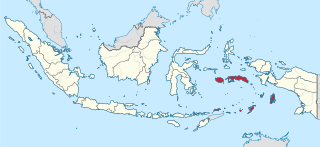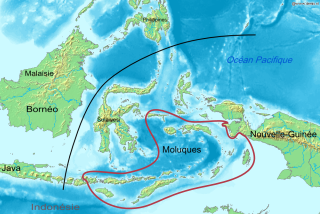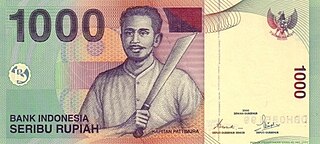Related Research Articles

Ambon Island is part of the Maluku Islands of Indonesia. The island has an area of 743.37 km2 (287.02 sq mi) and is mountainous, well watered, and fertile. Ambon Island consists of two territories: the city of Ambon to the south and various districts (kecamatan) of the Central Maluku Regency to the north. The main city and seaport is Ambon, which is also the capital of Maluku province, while those districts of Maluku Tengah Regency situated on Ambon Island had a 2020 Census population of 128,069. Ambon has an airport and is home to the Pattimura University and Open University, state universities, and a few private universities, which include Darussalam University and Universitas Kristen Indonesia Maluku (UKIM).
In addition to its classical and literary form, Malay had various regional dialects established after the rise of the Srivijaya empire in Sumatra, Indonesia. Also, Malay spread through interethnic contact and trade across the Malay Archipelago as far as the Philippines. That contact resulted in a lingua franca that was called Bazaar Malay or low Malay and in Malay Melayu Pasar. It is generally believed that Bazaar Malay was a pidgin, influenced by contact among Malay, Hokkien, Portuguese, and Dutch traders.
Manado Malay, or simply the Manado language, is a creole language spoken in Manado, the capital of North Sulawesi province in Indonesia, and the surrounding area. The local name of the language is bahasa Manado, and the name Minahasa Malay is also used, after the main ethnic group speaking the language. Since Manado Malay is used primarily for spoken communication, there is no standard orthography.

Maluku is a province of Indonesia. It comprises the central and southern regions of the Maluku Islands. The main city and capital of Maluku province is Ambon on the small Ambon Island. The land area is 62,946 km2, and the total population of this province at the 2010 census was 1,533,506 people, rising to 1,848,923 at the 2020 Census. The official estimate as at mid 2021 was 1,862,626. Maluku is located in Eastern Indonesia. It is directly adjacent to North Maluku, Southwest Papua, and West Papua in the north, Central Sulawesi, and Southeast Sulawesi in the west, Banda Sea, East Timor and East Nusa Tenggara in the south and Arafura Sea, Central Papua and South Papua in the east.
The Sawai language is a South Halmahera language of Austronesian stock spoken in the Weda and Gane Timor districts of southern Halmahera, northern Maluku Province, Indonesia. There are approximately 12,000 speakers.

The Central Malayo-Polynesian languages (CMP) are a proposed branch in the Malayo-Polynesian subgroup of the Austronesian language family. The languages are spoken in the Lesser Sunda and Maluku Islands of the Banda Sea, in an area corresponding closely to the Indonesian provinces of East Nusa Tenggara and Maluku and the nation of East Timor, but with the Bima language extending to the eastern half of Sumbawa Island in the province of West Nusa Tenggara and the Sula languages of the Sula archipelago in the southwest corner of the province of North Maluku. The principal islands in this region are Sumbawa, Sumba, Flores, Timor, Buru, and Seram. The numerically most important languages are Bima, Manggarai of western Flores, Uab Meto of West Timor, and Tetum, the national language of East Timor.
Tidore is a language of North Maluku, Indonesia, spoken by the Tidore people. The language is centered on the island of Tidore, but it is also spoken in some areas of the neighbouring Halmahera. A North Halmahera language, it is unlike most languages in Indonesia which belong to the Austronesian language family. Tidore and other North Halmahera languages are perhaps related to languages of the Bird's Head Peninsula, West Papua.

Pattimura International Airport is an airport in Ambon, Maluku. The airport is located 38 kilometers west of the city of Ambon. The airport was named after Pattimura (1783–1817), an Indonesian national hero who fought against the Dutch colonialists in the nineteenth century. Pattimura Airport is an airport located in Ambon City, Maluku Province, Indonesia. The airport also caters for domestic and overseas trips. The airport is 35 kilometers outside Ambon City with travel time approximately 30–45 minutes. At this airport there are immigration facilities, quarantine, customs, cargo building, restaurant, public phone, and post office. Pattimura Airport Ambon is a very strategic area in the Maluku Islands which is divided into two provinces namely, North Maluku and Maluku. Pattimura Ambon Airport is located in Ambon Island, located in Maluku Province.

Thomas Matulessy, also known as Kapitan Pattimura or simply Pattimura, was a famous Ambonese soldier who became a symbol of both the Maluku and Indonesian struggle for independence, praised by President Sukarno and declared a national hero by President Suharto. He has several namesakes in both the Netherlands and in the Indonesian archipelago.
Moronene is an Austronesian language spoken in Bombana Regency, Southeast Sulawesi, Indonesia. It belongs to the Bungku–Tolaki branch of the Celebic subgroup.
The Piru Bay languages are a group of twenty Malayo-Polynesian languages, spoken on Ambon Island and around Piru Bay on the island of Seram. None of the languages have more than about twenty thousand speakers, and several are endangered with extinction.
University of Pattimura is a public university in Ambon, Maluku, Indonesia. It was established on April 23, 1963. Its current rector is Prof. Dr. M. J. Saptenno, SH. M.Hum.
Larantuka Malay is a contact variety of Malay spoken in and around the city of Larantuka on the island of Flores in Indonesia, and in two enclaves: the village of Wure on the island of Adonara and four villages on Konga Bay, about 40 kilometers south of Larantuka on Flores, and serves more generally as a lingua franca on the eastern tip of Flores and nearby islands. There are approximately 23,000 native speakers of Larantuka Malay. Second language speakers of Larantuka Malay are primarily found in and around the city of Larantuka and through the eastern part of Flores island, as well as the nearby islands of Adonara, Solor and Lembata (Lomblen), and natively speak Lamaholot or other languages closely related to Lamaholot, which, until recently, were believed to be dialects of Lamaholot. The city of Larantuka today is a fairly homogeneous community, and although it is largely made up of speakers of Larantuka Malay, many of whom who trace their ancestry back to Portuguese settlers and their followers from the Malay peninsula who arrived in Larantuka in the 17th century, it actually had roots in diverse communities drawn to the settlement. The Larantuka Malay community maintains a separate cultural and linguistic identity from the Lamaholot speakers who surround the city. Larantuka Malay serves as the main language of daily life in the city, and is the native language of a majority of the population.
Kei is an Austronesian language spoken in a small region of the Moluccas, a province of Indonesia.
Ternate is a language of northern Maluku, eastern Indonesia. It is spoken by the Ternate people, who inhabit the island of Ternate and some other areas of the archipelago, including the western coast of Halmahera, Hiri, Obi, Kayoa, and the Bacan Islands. Historically, it served as the primary language of the Sultanate of Ternate, famous for its role in the spice trade. It has established itself as a lingua franca of the North Maluku province. A North Halmahera language, it is unlike most languages of Indonesia which belong to the Austronesian language family.

The North Halmahera languages are a family of languages spoken in the northern and eastern parts of the island of Halmahera and some neighboring islands in Indonesia. The southwestern part of the island is occupied by the unrelated South Halmahera languages, which are a subgroup of Austronesian. They may be most closely related to the languages of the Bird's Head region of West Papua, but this is not well-established.
Napu is an Austronesian language spoken in the North Lore district of Central Sulawesi, Indonesia. Together with Bada and Behoa, it belongs to the Badaic subgroup.
Suwawa is a Philippine language spoken in North Sulawesi (Celebes), Indonesia. It is also known as Bonda, Bone, Bunda, Bune, Suvava, and Toewawa. The language mostly spoken in Suwawa District, Regency of Bone Bolango.
Laiyolo (Layolo) or Loa’ is an Austronesian language of South Sulawesi, Indonesia. It is spoken at the southern tip of Selayar Island and belongs to the Wotu–Wolio branch of the Celebic subgroup.

Komando Daerah Militer XVI/ Pattimura abbreviated Kodam XVI / Pattimura is the Defense Regional Command which contains Maluku Islands.
References
- ↑ Wakasihu at Ethnologue (18th ed., 2015) (subscription required)
- ↑ Laidig & Laidig (1995)